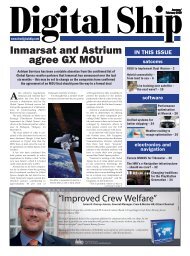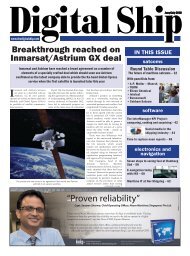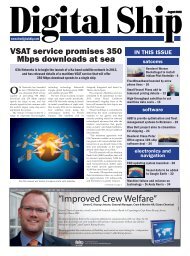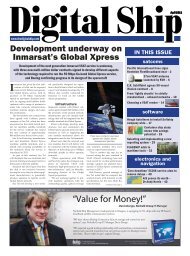Digital Ship
Digital Ship
Digital Ship
Create successful ePaper yourself
Turn your PDF publications into a flip-book with our unique Google optimized e-Paper software.
SATCOMStherefore instantly determine whether hecan call the sender back for a question thatneeds clarifying or whether that person isbusy, and until what time.Software platformThe communication platform is based onMicrosoft software. Initially BSM choseMicrosoft Office Communicator, whichhas been updated to Microsoft LYNC asnew versions have been released.The LYNC platform requires the use ofboth physical and virtual servers to runthe integrated solution, as Mr Vassiliouexplains.“Successful LYNC platform deploymentrequires the use of at least two physicalservers and a number of virtualservers each having a specific role,” hesaid. “Integration with telephony alsorequires LYNC compatible telephonedevices.”“This is the basic infrastructure. Ofcourse additional servers and gatewaydevices are required for redundancy foruninterrupted telephony service if LYNCenterprise telephony is deployed.”Voicemail messages can also be deliveredto Outlook as audio files. Thisensures that voicemail messages can bepicked up from anywhere in the worldwhenever internet access is available.The platform further allows call forwardingfrom the LYNC client to a user’sintegrated mobile phone, home number orto a colleague functioning as a backup.“The LYNC server is centrally hosted inBSM Datacenter and it is controlled by theBSM Cyprus IT Dept,” said Mr Vassiliou.“Local offices require only minimal ITsupport to set-up the client application onusers’ computers and provide brief training.The vital role of LYNC telephonyincreases the infrastructure requirementsand BSM is now planning to setup localLYNC servers for redundancy and uninterruptedtelephony service.”“When you deploy such a system isvery important to have reliability. Youcannot rely on a single server or a singleinternet provider or a single location.”Unifying communicationsat seaOf course, in addition to its more than 30land based locations BSM has a multitudeof vessels at sea at any one time, also actingas ‘floating offices’.To maximise the impact of the implementationof a unified communicationsplatform it is not only the employees in theoffices ashore that have to be connected tothe communication solution, but also themasters at sea.BSM’s vision is to make all employeeswithin the company available on the sameplatform, and allow them to be contactedusing all featured communication services.“In this vision the vessel becomesanother user in our directory,” said MrVassiliou.“We know the presence of the vessel; weknow the presence of the captain. On theother side the captain knows if the personhe wants to contact is in a meeting or available.He can contact them anytime. Imaginethe flexibility that the system provides!”“How many times do masters makecalls to the office trying to reach a personwhen the person is not there? So you saveon communication costs from the side ofthe vessel as well, because the master willget in touch with the person when he isavailable. Or he can just chat, which ismuch more flexible sometimes.”In order to evaluate the suitability ofthe communication platform for use onboard BSM vessels a trial was initiated,with a first sustainable system installed onthe container carrier ‘Mary Schulte’.Company employees’ profiles displaycontact details as well as informationabout the person’s schedule andavailabilityFor the system to function on board theforemost requirement for BSM was tohave an ‘always on’ internet connection.To enable this constant internet availability,the company decided to equip theMary Schulte with a mini-VSAT systemfrom KVH.The satcom service was deployed inmid-November 2010, and was the first systemof its kind to be installed on a BSMvessel. A FleetBroadband 150 was alsoinstalled, as a back-up solutionThe ‘fixed fee’ connection to the internetprovided by the VSAT system enablesthe vessel to become an active participantin the LYNC-based unified communicationplatform.The captain’s availability for communicationcan be instantly determinedthrough the ‘Presence’ tool, and telephonecalls over VoIP, as well as instant messaging,become possible.“The location of the vessel and thesatellite signal level is important for asolid internet connection without interruptions,”notes Mr Vassiliou.“So, depending on this parameter thecaller can initiate a VoIP session withoutinterruption in areas where the satellitesignal is strong, or compromise by usingIM which is reliable and smooth even inareas with weak satellite signal.”“Further to that, the ‘Presence’ featureallows the vessel to have online informationon the status of their contacts onshore, and saves time avoiding calls topeople that are not available to answer.”One result of a four month trial periodof the unified communications system onthe Mary Schulte was a significantincrease of in the mini-VSAT traffic to andfrom the ship.From a data volume of approximately340 MB in the first month of the VSATdeployment the traffic skyrocketed to justbelow 2 GB in month four of the trial period.So far there are currently 11 BSM vesselsthat use a VSAT system and so areconsequently in a position to avail of thenew communication platform.BSM says that it expects this number toincrease to nearly 100 over the next coupleof years.BSM also says it has seen a high level ofuser satisfaction since the introduction ofthe new platform, assisted by the fact thatthe set up and user introduction periodhas been quick and uncomplicated.“Initially LYNC access was provided tothose people identified with the higherneeds of overseas communication andtravelling,” notes Mr Vassiliou.“The response was very positive andsoon the software was as important tothem as their cell phones. By the end of2010 our platform had over 850 registeredusers. The client software and the integratedOutlook module have clear and easy tolearn functionality.”“A brief training of 30 minutes is morethan enough for an average user to make asolid start with this new technology.People use the LYNC platform with confidenceand comfort and they feel that theyhave in hand a great tool which helpsthem increase productivity and makestheir working life much easier.”Return on investmentThe implementation of a single communicationplatform across all of the offices,and potentially all of the vessels, of a globalcompany obviously requires a significantinitial financial investment.For BSM, given the size and distributionof the company, the initial investmentwas “substantial”, however the companyis confident that the return on investment(ROI) from integrating its communicationswill prove to be considerable.After a trial period of more than a yearBSM believes that this has been verified,and is today so convinced of the benefitsof the move that it speaks of a “guaranteedROI” on the project.Conventional intra-organisational telephonecosts between branches, to homeworkers as well as to company mobilephones have been dispensed with, andoffices in various geographic locations canavail of the benefit of least cost routeimplementation.“We have a huge number of callingsessions on a daily basis – ourOCS/LYNC platform statistics forJanuary/February 2011 (before the installationof LYNC telephony) showed thatcalls and conferences were exceeding 120sessions per day with an average durationof 15 minutes and 2.2 participants per session,”notes Mr Vassiliou.“That is a minimum of 33 hours of zerocost international telephony per day, consideringthat one or more people wouldpay for an international telephone callduring each session. These numbers areexpected to triple once LYNC telephony isfully deployed.”“If we add up the savings in the highlyreduced travelling expenses as people canperform online presentations and haveshared whiteboards beyond the use ofvideo conferencing, the ROI is guaranteedwithin a very short time.”Costs are further reduced on companycalls to third parties – instead of payingfor the full international rate, the call isrouted through the organisation’s branchservers, and only the local rate for phonecalls is charged.“Imagine someone in Cyprus wants tocall someone in Hong Kong, UK orGermany; the unified communicationssystem can route the phone call from theCyprus server to the Hong Kong serverand that server will initiate a phone call tothe third party,” said Mr Vassiliou.“So, forget overseas calls!”Other benefitsAfter a utilisation period of over a yearBSM, and Mr Vassiliou in particular, havealso been pleased with the effect that theintroduction of a unified communicationplatform had on the simplification of ITadministration, enabling the IT departmentto maintain a single platform ratherthan a multitude of different services.“Unified Communications is not a singleproduct, it is an environment,” said MrVassiliou.“It consists of several products whichare integrated together under one interface.Within one software [the user] canswitch between different actions just withthe click of a button.”The set up and update of user accounts,which is a vital requirement for the functionalityof an all-encompassing communicationplatform, is simplified. It takes nomore than 15 minutes for installation andconfiguration.BSM has seen a significant reduction inrequired travel as a result, with meetingsover video conference becoming increasinglyaccepted.“We had a huge decrease in travellingin 2010,” notes Mr Vassiliou.“People were travelling all over theworld to have meetings with shareholders,directors and managers. Forget all that!Now we are doing all meetings, evenimportant committee and managementmeetings online. There is no need to travelto another country for a meeting anymore.”“The user has a lot of flexibility. FromOutlook he can initiate instant messagingor a voice call without having to changethe interface.”The whole process of intra-organisationalcommunication is thus believed tobe operating at a vastly improved level ofefficiency compared with the previousinfrastructure, and financially the incorporationof the platform has proven a valuableinvestment for BSM.The voyage from inefficient communicationusing various different systems hasnow reached an end for BSM with theimplementation of the unified communicationsplatform. Tried and tested over a considerableperiod on shore and onboard thesystem has proven its value both financiallyand in terms of user satisfaction.The success BSM has had in deployingthe unified communication system onboard a vessel, as well as in the offices, hasalso convinced the company to continueequipping its fleet with the higher-usageinternet solutions necessary to facilitatethe communications platform.In fact, the experience had been so satisfactorythat BSM says that it would recommendthe implementation of such a systemfor any larger maritime organisation, and ispositive that an ROI is guaranteed for companiesthat have extensive branch to branchoverseas communication and a lot of intraorganisationaltravel.DS<strong>Digital</strong> June/July 2011 page 12








